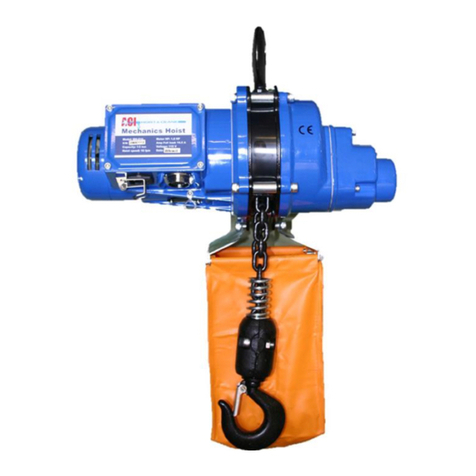
Lever Hoists PAGE: 2
Model MLH
MLH-005 & MLH-010
www.ACIHoist.com|© 2021 ACI HOIST. All rights reserved | 1-866-4-A-HOIST
TABLE OF CONTENTS
1.0 WARRANTY.............................................................................................................................................................................. 3
2.0 SAFETY PRECAUTIONS.............................................................................................................................................................. 4
2.1 Safety Alert Symbols ................................................................................................................................................................. 4
3.0 GENERAL DESCRIPTION............................................................................................................................................................ 5
3.1 Hoist Construction .................................................................................................................................................................... 5
4.0: PREPARATION & PROCEDURES ................................................................................................................................................ 6
4.1 Prepare for use ......................................................................................................................................................................... 6
4.2 Attachment Points .................................................................................................................................................................... 6
4.3 Mounting the Hoist................................................................................................................................................................... 6
4.4 Pre-Operational Checks & Trial Operation................................................................................................................................ 6
5.0 OPERATING INSTRUCTIONS...................................................................................................................................................... 6
5.1 Hoisting (Pulling & Lifting) and Lowering.................................................................................................................................. 6
5.2 Hoist Operation: Free Chain...................................................................................................................................................... 7
5.2.1 Principle ...................................................................................................................................................................... 7
5.2.2: Operation .................................................................................................................................................................. 7
6.0: PRECAUTIONS WHILE OPERATING ........................................................................................................................................... 8
6.1 Warnings................................................................................................................................................................................... 8
6.2 Attaching the Load.................................................................................................................................................................... 8
7.0: ROUTINE CARE, INSPECTION, AND MAINTENANCE .................................................................................................................. 8
7.1 General ..................................................................................................................................................................................... 8
7.2 Inspection Classification ........................................................................................................................................................... 9
7.2.1 Frequent/Visual Inspection......................................................................................................................................... 9
7.3 Frequent Inspection................................................................................................................................................................ 10
7.4 Periodic Inspection ................................................................................................................................................................. 10
7.5 Inspection Schedule................................................................................................................................................................ 10
7.6 Chain Inspection ..................................................................................................................................................................... 11
7.7 Hook Inspection...................................................................................................................................................................... 11
7.8 Reject Opening........................................................................................................................................................................ 11
7.9 Storage.................................................................................................................................................................................... 11
7.10 Lubrication ............................................................................................................................................................................ 11
7.10.1: Recommended Lubricants ..................................................................................................................................... 12
8.0: TROUBLESHOOTING GUIDE ................................................................................................................................................... 13
9.0 DIMENSIONS & SPECIFICATIONS............................................................................................................................................. 14
10.0: EXPLODED VIEW & PARTS LIST ............................................................................................................................................ 15
10.1 Exploded View ...................................................................................................................................................................... 15
10.2 Parts List................................................................................................................................................................................ 16






























